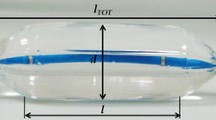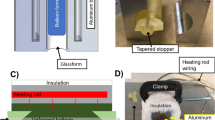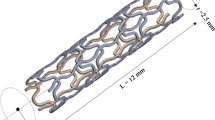Abstract
The forming of balloons used in medical treatment is a kind of “black box art”. When a new balloon is being developed, the process parameters and tube dimension are usually determined by a method of trial and error. This method is inefficient in current rapid development of computer technology. Numerical simulation is expected to replace the experiments and experience to guide the development of the new products. In this study, the moulding of the balloon was simulated by a finite element method and the results obtained from the simulation agreed with that of the experiments under the same actual process parameters. Therefore the numerical simulation used is feasible for the process of balloons forming. The effect of process parameters on the wall thickness of balloon was analyzed based on orthogonal design method. The results showed that the effect of first stretch rate on the wall thickness of the balloon was the most significant compared with other process parameters. A regression model of the relationship between wall thickness and the process parameters was established, which could be used to guide the selection of production process parameters.
Access this chapter
Tax calculation will be finalised at checkout
Purchases are for personal use only
Similar content being viewed by others
References
Xu, L., Liu, Y., Lu, C., et al.: State of aggregation changes of Nylon-12 balloon in molding process. Polymer Bull. 7, 104–110 (2012)
Wang, Z., Wang, S., Wu, J., et al.: Balloon dilatation and stent placement method for treatment of Budd Chiari syndrome. Chinese Med. J. 2, 97–99 (1995)
Ling, J., Xie, R., Xu, L., et al.: Experience and long-term outcome of percutaneous balloon pulmonary valvuloplasty. Chin. J. Cardiol. 5, 6–8 (2003)
Yang, H., Shi, X.: Research progress of medical balloon. In: The First National Conference on Interventional Medical Engineering, Shandong, Weihai, China (2007)
Shichong, X., Biao, G.: Application of nylon 12 in medical equipment. New Chem. Mater. 2, 183–184 (2014)
Menary, G.H., Armstrong, C.G.: Experimental study and numerical modelling of injection stretch blow moulding of angioplasty balloons. Plast., Rubber Compos. 35(8), 348–354 (2006)
Lv, C.: The optimization of process conditions and preform structure parameters for PET bottles. Doctoral dissertation. Zhejiang University (2014)
Jie, L., Yaomin, H.: Finite element analysis of superplastic bulging process. J. Plast. Eng. 15(3), 56–60 (2008)
Zhihan, P., Zupei, S.: Handbook of Plastics Industry: Polyamide. Chemical Industry Press, Beijing (2001)
Duan, Y., Saigal, A., Greif, R., et al.: A uniform phenomenological constitutive model for glassy and semicrystalline polymers. Polymer Eng. Sci. 41(8), 1322–1328 (2001)
Schang, O., Billon, N., Muracciole, J.M., et al.: Mechanical behavior of a ductile polyamide 12 during impact. Polymer Eng. Sci. 36(4), 541–550 (1996)
Zhang, K.: Numerical simulation of breadthwise stretching process of biaxially oriented plastics film. Doctoral dissertation. Nanchang University (2006)
Schmidt, L.R., Carley, J.F.: Biaxial stretching of heat-softened plastic sheets using an inflation technique. Int. J. Eng. Sci. 13(6), 563–578 (1975)
Delorenzi, H.G., Nied, H.F.: Blow molding and thermoforming of plastics: finite element modeling. Comput. Struct. 26(1–2), 197–206 (1987)
Erwin, L., Pollock, M.A., Gonzalez, H.: Blowing of oriented PET bottles: predictions of free blown size and shape. Polymer Eng. Sci. 23(15), 826–829 (2004)
Martin, L., Stracovsky, D., Laroche, D., et al.: Modeling and experimental validation of the stretch blow molding of PET. In: Annual Technical Conference of SPE, pp. 14–22 (1999)
Yeoh, O.H.: Some forms of the strain energy function for rubber. Rubber Chem. Technol. 66(5), 754–771 (1993)
Yong, H.U., Bolin, H., Hong, Y.: Numerical simulation of semi-solid die casting process of magnesium matrix composite. Chin. J. Nonferrous Met. 20(7), 1260–1266 (2010)
Wu, Y., Wu, A.: Taguchi Methods for Robust Design. Mech. Eng. 5, 78 (2001)
Gharaibeh, K.M.: Simulation of nonlinear systems in MATLAB ® nonlinear distortion in wireless systems: modeling and simulation with MATLAB, pp. 221–278 (2011)
Acknowledgements
The authors thank the support from CHEMCLOUDCOMPUTING@BUCT.
Author information
Authors and Affiliations
Corresponding author
Editor information
Editors and Affiliations
Rights and permissions
Copyright information
© 2017 Springer International Publishing AG
About this paper
Cite this paper
Fu, X., He, H., Wang, W. (2017). Numerical Simulation of Forming Process Conditions and Wall Thickness for Balloon. In: Huang, Y., Wu, H., Liu, H., Yin, Z. (eds) Intelligent Robotics and Applications. ICIRA 2017. Lecture Notes in Computer Science(), vol 10464. Springer, Cham. https://doi.org/10.1007/978-3-319-65298-6_72
Download citation
DOI: https://doi.org/10.1007/978-3-319-65298-6_72
Published:
Publisher Name: Springer, Cham
Print ISBN: 978-3-319-65297-9
Online ISBN: 978-3-319-65298-6
eBook Packages: Computer ScienceComputer Science (R0)




